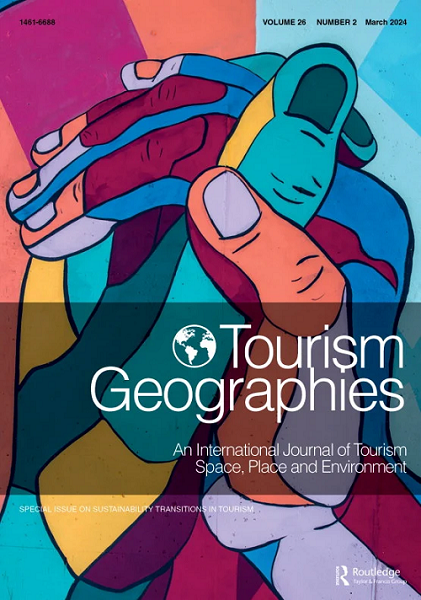Confronting historical narratives at the Castillo de San Marcos, Saint Augustine, Florida
IF 4.1
3区 管理学
Q1 HOSPITALITY, LEISURE, SPORT & TOURISM
引用次数: 0
Abstract
AbstractRecent research on intangible cultural heritage and the politics of contested sites of memory show that the emotional dimensions of historic places change over time and influence what visitors experience. These dimensions also influence interpretive strategies and historical narratives within sites that are public tourist destinations. In this regard, the Castillo de San Marcos in Saint Augustine, Florida posits significant challenges. As a national monument situated in a scenic, sea-side town, it is a symbol of Spanish Florida and part of the National Park Service (NPS). Conveyed as the place where ‘America begins,’ the lesser-known history is that, when operated under the United States military as Fort Marion (1825–1924), it was the site of three periods of Native American incarceration and the foundation of an educational system for forced assimilation. Within this context, this essay focuses on three questions: How does a governmental entity such as the NPS present complicated histories experienced at tourism sites? In what ways can the Castillo become a place that goes beyond Native American existence or disappearance to present complex narratives of survival and active resistance? And, to what extent can tourism sites become agents of change to confront settler colonialism through centering new voices? Through the concept of survivance and centering Indigenous perspectives and voices, national parks can broaden interpretations and create more complex narratives of history.Keywords: Landscapes of memorynational parkstourismdecolonizationNative Americanssurvivance AcknowledgementsI thank Porchia Moore, Jacque Micieli-Voutsinas, Lourdes Santamaría-Wheeler, and Silvio dos Santos for their support and guidance throughout this project. I also thank the editors of this issue and the anonymous reviewers for their careful reading and suggestions towards strengthening this essay.Disclosure statementThe author reports there are no competing interests to declare.Additional informationNotes on contributorsIvy ChenIvy Chen is a graduate student in Latin American Studies at the University of Florida, where she received her MA in Museum Studies (2022). Her research explores national parks and national belonging.在佛罗里达州圣奥古斯丁的圣马科斯城堡直面历史叙事
摘要最近对非物质文化遗产和有争议的记忆地点的政治的研究表明,历史地点的情感维度随着时间的推移而变化,并影响游客的体验。这些维度也影响着作为公共旅游目的地的遗址的解释策略和历史叙述。在这方面,佛罗里达州圣奥古斯丁的圣马科斯城堡提出了重大挑战。作为位于风景秀丽的海边小镇的国家纪念碑,它是西班牙佛罗里达州的象征,也是国家公园管理局(NPS)的一部分。作为“美国的起源”,鲜为人知的历史是,当美国军队将其作为马里恩堡(1825-1924)运作时,它是三次美洲原住民监禁的地点,也是强制同化教育系统的基础。在此背景下,本文主要关注三个问题:一个像国家公园管理局这样的政府实体如何呈现在旅游景点经历的复杂历史?卡斯蒂略怎样才能成为一个超越印第安人存在或消失的地方来呈现关于生存和积极抵抗的复杂叙事?在多大程度上,旅游景点可以通过集中新的声音,成为对抗定居者殖民主义的变革媒介?通过生存的概念和以土著视角和声音为中心,国家公园可以拓宽解释,创造更复杂的历史叙事。关键词:纪念景观国家公园旅游非殖民化美洲原住民生存致谢感谢Porchia Moore、Jacque micielli - voutsinas、Lourdes Santamaría-Wheeler和Silvio dos Santos在整个项目中给予的支持和指导。我也感谢本期的编辑和匿名审稿人对本文的仔细阅读和建议。披露声明作者报告无竞争利益需要申报。陈薇(ivy Chen)是佛罗里达大学拉丁美洲研究专业的研究生,她于2022年获得博物馆研究硕士学位。她的研究探讨了国家公园和国家归属。
本文章由计算机程序翻译,如有差异,请以英文原文为准。
求助全文
约1分钟内获得全文
求助全文
来源期刊

Tourism Geographies
HOSPITALITY, LEISURE, SPORT & TOURISM-
CiteScore
25.90
自引率
3.10%
发文量
19
期刊介绍:
Tourism Geographies is a peer-reviewed journal that focuses on exploring tourism and its related areas of recreation and leisure studies from a geographic perspective. It brings together academic and applied research as well as regional traditions from across the globe. The journal welcomes multidisciplinary approaches from fields such as geography, anthropology, landscape architecture, urban and regional planning, and environmental science and management. Tourism Geographies publishes various types of content including research articles, review articles, commentaries, literature reviews, and news related to affiliated organizations. All research articles and commentaries in the journal undergo a rigorous peer review process, including editor screening and double-anonymized evaluation conducted by two to three anonymous referees.
 求助内容:
求助内容: 应助结果提醒方式:
应助结果提醒方式:


